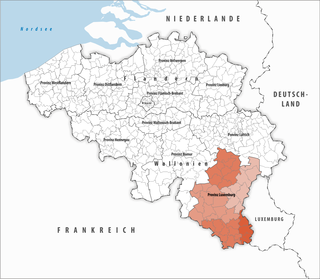Luxembourg Province
|
Luxembourg Luxembourg ( Dutch ) Luxembourg ( French ) |
|
| Country: | Belgium |
| Region : | Wallonia |
| Capital: | Arlon |
| Area : | 4,440 km² |
| Residents | 284,638 (Jan 1, 2019) |
| Population density | 64 inhabitants / km² |
| surface | 4,440 km² |
| Municipalities : | 44 |
| Website: | www.province.luxembourg.be |
| NIS code | 80000 |
| politics | |
|---|---|
| Governor: | Olivier Schmitz ( CdH ) |
| Location of the province in Belgium | |
|
|
|
| 44 municipalities in the province | |
The province of Luxembourg ( French Luxembourg , Walloon Lussimbork ) is a province in the Walloon part of Belgium . The province is located in southeast Belgium on the border with today's Grand Duchy of Luxembourg . The provincial capital is Arlon ( Arel in German and Luxembourg , Aarlen in Dutch ).
Luxembourg is the largest province in Belgium in terms of area, but also has the fewest inhabitants. It is divided into five administrative districts.
The Baraque de Fraiture near Vielsalm is at 652 m the highest point in the province.
history
At the time of the German Confederation, the area belonged to the Grand Duchy of Luxembourg. At that time the Grand Duke was the King of the Netherlands in personal union. After the Belgian Revolution of 1830 and the resulting secession of the southern provinces of the Netherlands, what was then Luxembourg was divided between Belgium and the Netherlands. The division ran only partially along the German-French language border.
Districts
The province of Luxembourg is divided into five districts. These are in French as arrondissements and in Dutch as arrondissementen referred. Sometimes the term arrondissement is also used in German, although district is the official term.
| district | Communities | Residents January 1, 2019 |
Area km² |
Density of population / km² |
NIS code |
|---|---|---|---|---|---|
| Arlon | 5 | 62,623 | 317.28 | 197 | 81000 |
| Bastogne | 8th | 48,413 | 1,042.99 | 46 | 82000 |
| Marche-en-Famenne | 9 | 56,476 | 953.70 | 59 | 83000 |
| Neufchâteau | 12 | 63,375 | 1,354.57 | 47 | 84000 |
| Virton | 10 | 53,751 | 771.17 | 70 | 85000 |
| Luxembourg Province | 44 | 284,638 | 4,439.71 | 64 | 80000 |
Communities
The province comprises a total of 44 municipalities (see info box for the location of the municipality in the province):
- Arlon
- Attert
- Aubange
- Bastogne
- Bertogne
- Bertrix
- bouillon
- Chiny
- Daverdisse
- Durbuy
- Érezée
- Étalle
- Fauvillers
- Florenville
- Gouvy
- Habay
- Herbeumont
- Hotton
- Houffalize
- La Roche-en-Ardenne
- Léglise
- Libin
- Libramont-Chevigny
- Manhay
- Marche-en-Famenne
- Martelange
- Meix-devant-Virton
- Messancy
- Musson
- Nassogne
- Neufchâteau
- Paliseul
- Rendeux
- Rouvroy
- Sainte-Ode
- Saint-Hubert
- Saint-Léger
- Tellin
- Tenneville
- Tintigny
- Vaux-sur-Sûre
- Vielsalm
- Virton
- Wellin
Part of the municipal tasks of the municipalities is taken care of by the Intercommunale IDELUX .
economy
In comparison with the gross domestic product per capita in the European Union, expressed in purchasing power standards , the province of Luxembourg achieved an index of 75 (EU-25: 100) in 2015, significantly lower than the Belgian average of 119. Luxembourg thus has the lowest per capita economic output among all Belgian provinces.
In 2017 the unemployment rate was 6.7%.
Culture and sights
The most important cultural museum in the province is the Fourneau Saint Michel open-air museum with an agricultural and a mining history section. There are important megalithic sites near Wéris .
literature
- Nikolaus Warker : Wintergreen. Legends, stories, legends and fairy tales from the province of Luxembourg , Arlon 1890 ( digital copies ).
Web links
- Website of the Province de Luxembourg
- Official website of the Belgian Luxembourg Tourism Association
Individual evidence
- ↑ Eurostat. Retrieved April 27, 2018 .
- ↑ Unemployment rate, by NUTS 2 regions. Retrieved November 5, 2018 .




